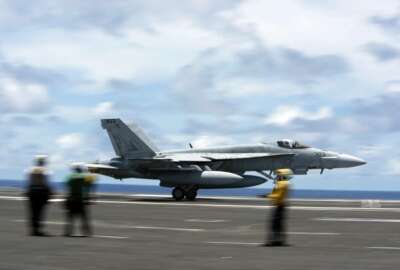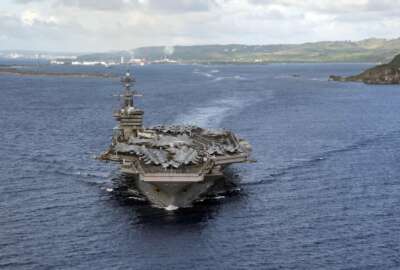
After ship fire in port, is Navy capable of responding to China policy?
If the United States is to make some sort of containment of China a foreign policy priority, the Navy would have a big part of the job.
Best listening experience is on Chrome, Firefox or Safari. Subscribe to Federal Drive’s daily audio interviews on Apple Podcasts or PodcastOne.
If the United States is to make some sort of containment of China a foreign policy priority, the Navy would have a big part of the job. But is the Navy fully capable? The recent burning of an important ship while in port is the latest event to call into question the basic condition of the Navy. James Russell is associate professor in the Department of National Security Affairs at the Naval Postgraduate School. He talked about the implications on Federal Drive with Tom Temin.
Interview transcript:
Tom Temin: This Bonhomme Richard fire was really a disturbing thing to watch in and of itself, but it did come at the end of a string of issues with the Navy. Review them for us and what your takeaway is from what’s been happening over the last several years.
James Russell: Yes, well, thanks. And I’d like to state at the outset for your listeners that I work at the Naval Postgraduate School as a professor, but I’m here providing to you my personal opinions, not representing the views of NPS or the Department of the Navy.
Tom Temin: Got it.
James Russell: But the point of the Bonhomme Richard fire, it’s like all of us, I suppose, we look for sort of implications of these events. And the fact of the matter is that for the Navy, if one goes back six months, two years, four years, five years, you see a string of incidents that are really quite troubling. So the Bonhomme Richard fire, for example, comes on the heels of a very sort of troubling five or six months stretch just in the early part of 2020, which feature the firing, for example of Captain Crozier, which featured the firing of the Navy Secretary, which featured the removal of his successor who was acting in the Navy Secretary capacity at the time, and which also, of course, in the context of questions being raised in Congress, very serious questions being raised in Congress, over the ability of the Navy to deliver on its plans to increase the size of the fleet to this targeted number of 355 ships within sort of budgetary constraints. In this sort of communication back and forth between Congress and the Pentagon, the Senate in particular has made clear that it has no confidence in the Navy’s ability to be able to deliver a plan is has laid out in its 30 year shipbuilding plan. And this shipbuilding plan, of course, has been held up by the Secretary of Defense Mark Esper, and his nominee to take over the civilian side of the Pentagon, sort of program analysis function, was on the hill a couple of weeks ago, and called the Navy’s own plan, quote unquote, “not a credible document.” In which, as he said, this plan does not sort of accord with sort of fiscal realities that the country is facing, fiscal realities I might add, that are only getting worse as we are struggling to sort of get on the other side of the pandemic and we’re looking at having to sort of basically we’re in the business now of printing money, stop people from going hungry, which which is only going to increase the pressure on the services budget. And of course, the Navy’s response to the criticisms of this basic phenomenon of its ability to deliver ships as advertised, on schedule, and on budget — the Navy’s response has basically been give us more money,
Tom Temin: Right. And they’ve had some expensive deals here with the Littoral Combat ship, the carrier program. But if you look at even the longer picture, the welds are very barely cooled off from repairs of ships that crashed a few years ago in the western Pacific. So that was a failure of training and of the seamanship basic of the people standing there on the bridge operating the ship — so it sounds like they have issues from the very top leadership on down to the people that are operating at night in a control room.
James Russell: To the Navy’s credit, I would say that after the incidents in the Pacific Fleet, they commissioned a group of experts to go and look at what had happened. And some of them were Naval Postgraduate School people served on the review of what had gone on. And I would urge all of your listeners who are interested in and concerned about the Navy to read the readiness report, which details a litany of problems in the fleet. But a very troubling characteristic of those problems was that not necessarily, although they are troubling, but the fact that the problems existed, it’s that the lower levels of the fleet had reported these problems of persistent, lack of competencies up the chain of command for the Navy leadership. The Navy leadership did not respond to the repeated sort of warnings that were coming up to it from the bottom of the sort of pyramid. The Navy since this has come out in 2017, I think they’re taking aggressive steps to try and fix this, which means basically, that they are going to have to say no to some of the mission requests that are being handed down to them by the combatant commands. So this again is a difficult issue. And I think the Navy is moving out on it. But again, we have this this pattern of problems of the leadership, which ignores the warnings from below, refuses to take action until there is these incidents. And you have to understand that when there’s something like a crash, just like an airplane crash or anything, there’s always this sort of pyramid below the incident that has piled up iteratively over time to have produced this problem, this crash in the case.
Tom Temin: I guess you’d call those systemic problems — and systemic problems, never have simple fixes. But it seems like some of the problems of the Navy are also rooted in the political leadership and in the way that the foreign policy has been non conducted, you might say, over the last several years over the past maybe 10, 12 years even.
James Russell: Yeah, so this gets to a broader issue, I think of so we have, which is tied to circumstance — so the circumstance of the United States over the last 20 years is that we have been engaged in land wars all across South Asia. The Army has been deployed to Iraq and Afghanistan. And frankly, the Navy has been in a kind of supporting role. They have, of course, actively supported the deployments of the land forces. But now the country seems to be in a place where the political leadership of the countries in a place where we are, I think this is the right thing. Bringing the forces home. Which highlights of course, the Defense Department’s new strategic priority of trying to counter the rise of Russia and China. So this puts the Navy at the front center in the national security strategy, a place that it has not had over the last 20 years. So the confrontation with China, we have to be honest about this in the South China Sea and across the Indo-Pacific is a maritime challenge. There isn’t any other way of describing it. So the Navy is being asked to shoulder an increasing sort of burden for taking on missions associated with this sort of strategic priority. So this is all happening, of course, in the context of a Naval buildup by China, in which of course, they are moving out aggressively across and developing a range of new weapons systems, which defense analysts would characterize as precision strike complexes, in which the idea is that you hold sort of targets or ships at risk with the range of munitions not just based at sea, but also based on land. And we see examples of this, for example, in Iran and North Korea, again, countries that have developed significant sort of different kinds of weapons systems that frankly call into question the ability of navies, including the American Navy, to operate in these quote unquote, contested areas. So here we have the strategic context again, the land wars drawing to a close, we have the return of the Navy to prominence. And we have sort of arguments very good and useful arguments I might add that are being voiced about a changing kind of strategic paradigm, or how the navies, and navies in general are supposed to be structured — the systems they’re going to need, their method of fighting, which then also gets to this broader question of what are navies for in the 21st century? What’s the purpose of navies? So all of these questions and the sort of debates about this, these are good things. So all of this is hitting the United States Navy sort of at the same time. Which again, comes on the heels of this sort of 20 year period where they have not had a particularly stellar record of being able to produce innovative new ship designs that meet basic reliability and warfighting standards. They’ve established a track record, in fact, over the last 20 years, showing an inability to bring innovative new designs, and to be able to generalize those innovative new designs to make them accessible to the fleet writ large. So all of these things are kind of colliding together with regrettably the COVID panedemic and the budgetary pressure on the defense budget. And hence you have the Defense Department’s experts up on the hill sort of saying these plans don’t reflect the strategic and budget reality. The Navy would be needing significantly more money for shipbuilding over the rest of the decade and beyond if it’s going to realize its plans to grow the fleet.
Tom Temin: Alright, so basically they need to be ready to be ready.
James Russell: Yes, that’s correct. But it’s broader than just that. It’s that I think there is really a national debate which is needed. And I think we’re starting to sort of see that, which is that the issue is bigger than just giving the Navy more money. It’s having a real sort of discussion about what are the purposes of navies in the 21st century? And I think those of us in the academic business would sort of say that, back in the late sort of 19th, early 20th centuries, there was no question that having strong navies was seen as sort of instrumental to national power and influence. And I think that’s a question for the 21st century. It’s not clear that’s really the case, or it’s clear that the context has changed, but we need to sort of have a discussion about this. So all these issues are in play.
Copyright © 2024 Federal News Network. All rights reserved. This website is not intended for users located within the European Economic Area.
Tom Temin is host of the Federal Drive and has been providing insight on federal technology and management issues for more than 30 years.
Follow @tteminWFED





